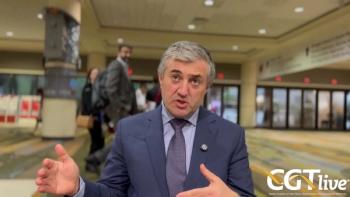
Outcome Measures for Spinal Cord Injury Clinical Trials Need Reexamination
Mary Jane "MJ" Mulcahey, PhD, OTR/L, CPPC, CLCP, FASIA, the director of the Center for Outcomes and Measurement in the Jefferson College of Rehabilitation Sciences at Thomas Jefferson University, discussed recommendations on outcome measures she presented at the first Annual SCI Investor Symposium.
Research evaluating novel treatments for spinal cord injuries (SCIs) is currently ongoing across multiple clinical and preclinical studies. Investigational treatments such as Lineage Cell Therapeutics’
In light of the activity going on in this space, Lineage and the Christopher & Dana Reeve Foundation launched the first Annual SCI Investor Symposium, which was held this year on June 29, in San Diego, California. At the meeting, Mary Jane "MJ" Mulcahey, PhD, OTR/L, CPPC, CLCP, FASIA, the director of the Center for Outcomes and Measurement in the Jefferson College of Rehabilitation Sciences at Thomas Jefferson University, gave a talk about her research on outcome measures used in clinical trials for SCI therapeutics targeting the central nervous system.
In an interview with CGTLive™, Mulcahey discussed the rationale behind her research and the key implications of the findings. She emphasized the limitations of the outcome measures that are currently being used and offered suggestions for new alternatives.
CGTLive: Can you give an overview of what you presented at the first Annual SCI Investor Symposium?
Mary Jane "MJ" Mulcahey, PhD, OTR/L, CPPC, CLCP, FASIA: My presentation was about some of the inherent limitations of existing outcome measures that are used in clinical trials that target the central nervous system and why those limitations may adversely impact our ability to interpret our results accurately... I think that the key recommendations from the presentation are: One, we need better and more precise outcome measures for efficacy studies that are trying to evaluate the impact of therapeutics for the nervous system; the second is that there's promise in imaging biomarkers, specifically diffusion tensor imaging biomarkers, to serve as an objective measure of spinal cord integrity that may be useful in the future—and that we should try to accelerate that capability; the third is when we think about clinically meaningful change in our outcome measures, since there is such a wide variety and variability among people with spinal cord injury, clinical change that was meaningful for one person may not be meaningful for another person—and so there’s a “one size doesn't fit all” concept that we need to be very thoughtful of when we talk about meaningful clinical change. The last consideration was: are we asking too much of our therapeutics targeting the central nervous system when we begin to evaluate quality of life and life satisfaction and participation in the community? Those outcomes may be a real big ask for a therapeutic directed towards the central nervous system and there's challenges in measuring those.
What would you say are the main implications of this research for healthcare providers?
The main implication of the research around outcome measures is that healthcare providers really need to understand some of the limitations of the outcome measures so that when they interpret outcomes of care or outcomes of studies their interpretation is in light of the limitations. [We need to be] very careful in making sure that we don't overstate our outcomes or understate our outcomes.
Can you speak to the challenges in this space?
Coming from a measurement field, we definitely need more funding to validate precise outcome measures; developing good measures takes time and it takes funding. What I believe is that if we're going to move forward with these expensive clinical trials that hold so much promise for people with spinal cord injury it's incumbent upon us to have valid and precise measures that actually can evaluate those study endpoints.
Are there any investigational therapies for spinal cord injuries that you think are of particular interest right now?
In addition to the cell-based therapies and some of the biologicals, I think that epidural stimulation is very exciting and holds promise—it's doing something—and so I think that's very exciting. I also think functional electrical stimulation is on the near horizon and very, very exciting as well.
Is there anything else you'd like to share with the audience?
I think I'd like to just share that when we evaluate outcomes of people living with spinal cord injuries: It's challenging, it's complex, it's not a straight line to the end—and so, again, my recommendation is when we use different outcome measures that we’re very thoughtful about the selection and we’re very careful about our interpretation of the scores.
Transcript edited for clarity.
REFERENCE
Lineage and the Christopher & Dana Reeve Foundation proudly present the 1st Annual Spinal Cord Injury Investor Symposium. News release. Lineage Cell Therapeutics, Inc. March 30, 2023. Accessed June 30, 2023. https://ir.teknova.com/news-releases/news-release-details/teknova-launches-proprietary-aav-tektm-solutions-gene-therapy
Newsletter
Stay at the forefront of cutting-edge science with CGT—your direct line to expert insights, breakthrough data, and real-time coverage of the latest advancements in cell and gene therapy.
















































